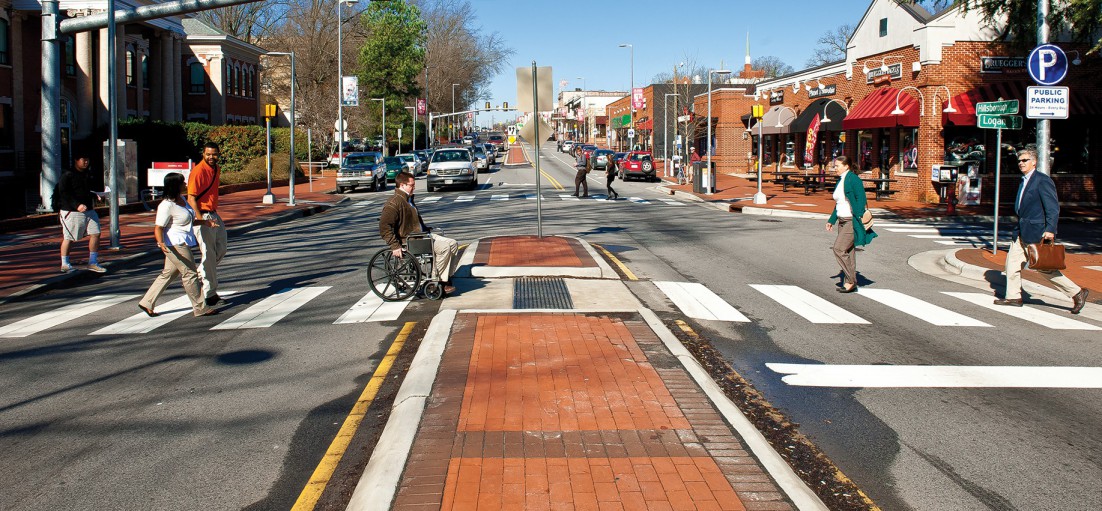Recommendations
Safety and Data Analysis
Issue: NCDOT collects and analyzes bike and pedestrian crash data on an ongoing basis.
View full map of bicycle and pedestrian crashes across North CarolinaCurrently, NCDOT, with the assistance of the Highway Safety Research Center, is geocoding the locations of historical data. Municipalities also often maintain a separate database of crash information that are coded in a unique way. Analysis reports of crash types have been developed but need to better inform countermeasures and design decisions. In certain cases, bicycle and pedestrian crashes are reported incorrectly by law enforcement or not reported at all. Finally, countermeasures are often implemented in reactive manner as opposed to preventative method.
Policy Direction: NCDOT plans to expand its collection and analysis of bicycle and pedestrian crash data. The agency should continue to use crash data to better understand trends and how they can be improved and to prioritize investments, through independent and routine accommodations. The agency should also work with municipalities, hospital systems, and DHHS Injury Prevention to gain more data about pedestrian and bicyclist injuries. Efforts should be made to "get ahead" and prevent crashes rather than reacting to crash fatalities.
NCDOT plans to move forward with two distinct, but equally important, sets of actions: 1) Pro-active strategies for preventing bicycle and pedestrian crashes based on established research, North Carolina-based data, and crash occurrences and 2) Strategies to improve crash reporting/data and using that information to prioritize infrastructure investments in the future.
Action Items/Proactive Safety Strategies:
A. Implement "Complete Streets" approach consistently with appropriate roadway projects to ensure a connected, accessible, and safe pedestrian and bicycle network. Evaluate facilities and programs for their capability to improve motorist/pedestrian/ bicyclist compliance and safety. Utilize national studies to support design solutions for safety improvement (see Chapter 6 – Pedestrian & Bicycle Toolbox).
B. Develop a strategy to advertise and educate NCDOT Division staff, MPOs/RPOs, cities, counties, advocates, and law enforcement staff across the state about HSRC crash analysis and data and trends in North Carolina. As part of this, NCDOT recently developed a mapping application available on DBPT's website to show crash information.
C. Maintain the NCDOT Traffic Safety Unit approach to review high crash locations. This team should be proactive using pedestrian/bicycle crash data regularly.
D. Develop an injury minimization approach for setting speed limits on new roadways and major roadway reconstruction projects. The approach should identify the intended operational speed at the outset of a project based on the context and local preferences.
E. Implement education, encouragement, and enforcement programs as detailed in Chapter 7.
F. Engage more stakeholders in a comprehensive approach to improving safety for bicyclists and pedestrians. Remain current with research regarding bicycle safety as bicycle planning and design is evolving rapidly in the United States.
G. Address safety needs of different types of bicyclists described in the WalkBikeNC Plan. Bicycle networks should be planned and designed by NCDOT, with cooperation from MPOs/RPOs and municipalities, to create connected networks that provide facilities along arterials/collectors but also provide separated facilities such as multi-use paths and lower traveled roadways such as bicycle boulevards.
Action Items to Improve Safety Data:
A. Continue to explore ways to improve the quality and completeness of bicycle and pedestrian crash data, including working with municipalities, hospital systems/emergency response, law enforcement, HSRC, and MPOs/RPOs to more consistently and accurately record crash events and to share data.
B. As part of increased engagement as suggested above, establish Statewide Pedestrian and Bicycle Safety Consortium to develop consistent, thorough recording of crashes that will allow for more comprehensive, consistent databases. The Consortium could also support WatchForMeNC program.
C. Evaluate the existing HSIP prioritization and project programming process to improve relationship between bicycle and pedestrian crash data and project selection.
D. Conduct studies to isolate high pedestrian and bicycle crash locations and coordinate results with the HSIP process to provide pedestrian countermeasures in these locations. The agency should explore the development of a model to estimate pedestrian and bike volumes, with the purpose of developing better prioritization methods that account for crash rates in addition to crash frequency. If possible, the model should be compatible and/or coordinated with analytical models currently used by other state agencies.





